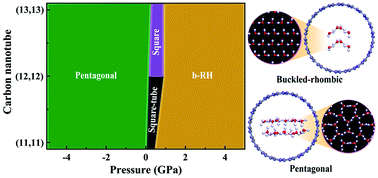The pressure induced phase diagram of double-layer ice under confinement: a first-principles study†
Abstract
Here, we present double-layer ice confined within various carbon nanotubes (CNTs) using state-of-the-art pressure induced (−5 GPa to 5 GPa) dispersion corrected density functional theory (DFT) calculations. We find that the double-layer ice exhibits remarkably rich and diverse phase behaviors as a function of pressure with varying CNT diameters. The lattice cohesive energies for various pure double layer ice phases follow the order of hexagonal > pentagonal > square tube > hexagonal-close-packed (HCP) > square > buckled-rhombic (b-RH). The confinement width was found to play a crucial role in the square and square tube phases in the intermediate pressure range of about 0–1 GPa. Unlike the phase transition in pure bilayer ice structures, the relative enthalpies demonstrate that the pentagonal phase, rather than the hexagonal structure, is the most stable ice polymorph at ambient pressure as well as in a deep negative pressure region, whereas the b-RH phase dominates under high pressure. The relatively short O⋯O distance of b-RH demonstrates the presence of a strong hydrogen bonding network, which is responsible for stabilizing the system.



 Please wait while we load your content...
Please wait while we load your content...